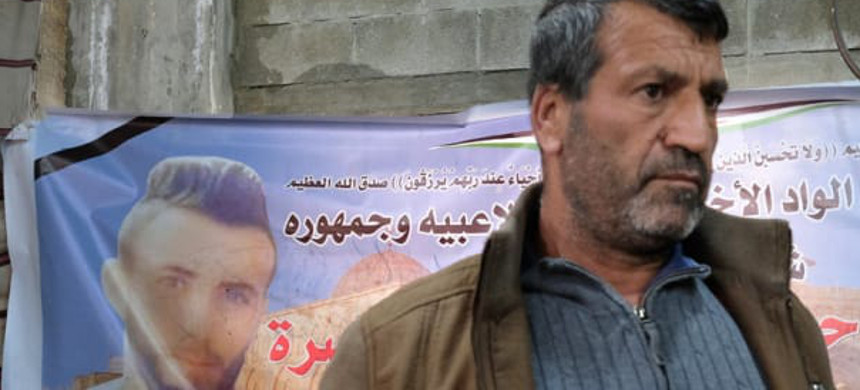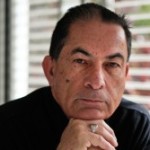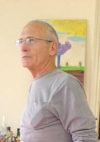Even for the West Bank, This Is a Shocking Story
PALESTINE - ISRAEL, 1 Apr 2019
Gideon Levy and Alex Levac | Haaretz – Reader Supported News
A young Palestinian’s attempt to help a stranger shot by Israeli troops costs him his life

Jamal, Ahmad Manasra’s father. A mourning poster for Ahmad is in the background.
(Photo: Alex Levac/Haaretz)
29 Mar 2019 – It was appallingly cold, rainy and foggy on Monday of this week at the southern entrance to Bethlehem. A group of young people stood on the side of the road, gazing at something. Gloomy and toughened, they formed a circle around the concrete cube in which are sunken the spikes of a large billboard – an ad for Kia cars that stretches across the road. They were looking for signs of blood, as though they were volunteers in Zaka, the Israeli emergency response organization. They were looking for bloodstains of their friend, who was killed there five days earlier. Behind the concrete cube they found what they were looking for, a large bloodstain, now congealed. The stain held fast despite the heavy rain, as though refusing to be washed away, determined to remain there, a silent monument.
This is where their friend tried, in his last moments, to find protection from the soldiers who were shooting at him, probably from the armored concrete tower that looms over the intersection a few dozen meters away. It was to here that he fled, already wounded, attempting to take cover behind the concrete cube. But it was too late. His fate was sealed by the soldiers. Six bullets slashed into his body and killed him. He collapsed and died next to the concrete cube by the side of the road.
Even in a situation in which anything is possible, this is an unbelievable story. It’s 9 P.M. Wednesday March 20. A family is returning from an outing. Their car breaks down. The father of the family, Ala Raida, 38, from the village of Nahalin, who is legally employed paving roads in Israel, steps out of his Volkswagen Golf to see what has happened. His wife, Maisa, 34, and their two daughters, Sirin, 8, and Lin, 5, wait in the car. Suddenly the mother hears a single shot and sees her husband lean back onto the car. Emerging from the car, she discovers to her astonishment that he’s wounded in the stomach. She shouts hysterically for help, the girls in the car are crying and screaming.
Another car, a Kia Sportage, arrives at the intersection. Its occupants are four young people from the nearby village of Wadi Fukin. They’re on the way home from the wedding of their friend Mahmoud Lahruv, held that evening in the Hall of Dreams in Bethlehem. At the sight of the woman next to the traffic light appealing for help, they stop the car and get out to see what they can do. Three of them quickly carry the wounded man to their car and rush him to the nearest hospital, Al-Yamamah, in the town of Al-Khader. The fourth young man, Ahmad Manasra, 23, stays behind to calm the woman and the frightened girls. Manasra tries to start the stalled car in order to move it away from the dangerous intersection, but the vehicle doesn’t respond. He then gets back out of the car. The soldiers start firing at him. He tries to get to the concrete cube but is struck by the bullets as he runs. Three rounds hit him in the back and chest, the others slam into his lower body. He dies on the spot.
The army says that stones were thrown. All the eyewitnesses deny that outright. Nor is it clear what the target of the stones might have been. The armored concrete tower? And even if stones were thrown at cars heading for the settlement of Efrat, is that a reason to open fire with live ammunition on a driver whose car broke down, with his wife and young daughters on board? Or on a young man who tried to get the car moving and to calm the mother and her daughters? Shooting with no restraint? With no pity? With no law?
We visit the skeleton of an unfinished apartment on the second floor of a house in Wadi Fukin. It’s an impoverished West Bank village just over the Green Line, whose residents fled in 1949 and were allowed to return in 1972, and which is now imprisoned between the giant ultra-Orthodox settlement of Betar Ilit and the town of Tzur Hadassah, which is just inside the Green Line. A wood stove tries to rebuff the bitter cold in the broad space between the unplastered walls and the untiled floor. A grim-looking group of men are sitting around the fire, trying to warm themselves. They are the mourners for Manasra; this was going to be his apartment one day, when he got married. That will never happen now.
Only the memorial posters remain in the unbuilt space. A relative and fellow villager, Adel Atiyah, an ambassador in the Palestinian delegation to the European Union, calls from Brussels to offer his shocked condolences. One of the mourners, Fahmi Manasra, lives in Toronto and is here on a visit to his native land. The atmosphere is dark and pained.
The bereaved father, Jamal, 50, is resting in his apartment on the ground floor. When he comes upstairs, it’s clear he’s a person deeply immersed in his grief though impressive in his restraint. He’s a tiler who works in Israel with a permit. He last saw his son as he drove along the main street in Bethlehem as his son was going to his friend’s wedding. Jamal was driving his wife, Wafa, home from another wedding. That was about two hours before Ahmad was killed. In the last two days of his life they worked together, Jamal and his son, in the family vineyard, clearing away cuttings and spraying. Now he wistfully remembers those precious moments. Ahmad asked to borrow his father’s car to drive to the wedding, but Jamal needed it to visit the doctor, and Ahmad joined the group in Wahib Manasra’s SUV.
Quiet prevails in the shell of the unfinished apartment. Someone says that Manasra was already planning the layout of his future home – the living room would be here, the kitchen there. Maisa Raida, the wife of the wounded driver, is at her husband’s bedside at Hadassah Medical Center, Ein Karem, Jerusalem, where he’s recovering from his severe stomach wound. He was brought there from Al-Khader because of the seriousness of his condition. Major damage was done to internal organs in his abdomen and he needed complicated surgery, but he seems to be on the mend.
Maisa told a local field investigator from a human rights group that at first she didn’t realize that her husband was wounded. Only after she stepped out of the car did she see that he was leaning on the vehicle because of the wound. She yelled for help, and after the young men stopped and took her husband to the hospital, she got back into the car with Manasra, whom she didn’t know. While they were in the car with her daughters, and he was trying get it started, she heard another burst of gunfire aimed at their car from the side, but which didn’t hit them.
She had no idea that Manasra was shot and killed when he got out of the car, moments later. She stayed inside, trying to calm the girls. It wasn’t until she called her father and her brother-in-law and they arrived and took her to Al-Yamamah Hospital that she heard that someone had been killed. Appalled, she thought they meant her husband but was told that the dead person had been taken to Al-Hussein Hospital in Beit Jala.
Eventually, she realized that the man who was killed was the same young man who tried to help her and her daughters; he was dead on arrival. Before Maisa and her daughters were taken from the scene, an officer and soldiers from the Israel Defense Forces came to the stalled car and tried to calm them.
Manasra was dead by then, sprawled next to the concrete cube. He was a Real Madrid fan and liked cars. Until recently he worked in the settlement of Hadar Betar, inside Betar Ilit. His little brother, 8-year-old Abdel Rahman, wanders among the mourners in a daze.
After Jamal Manasra returned home, his phone began ringing nonstop. He decided not to answer. He says he was afraid to answer, he had forebodings from God. He and his wife drove to the hospital in Beit Jala. He has no rational explanation for why they went to the hospital. From God. “I was the last to know,” he says in Hebrew. At the hospital, he was asked whether he was Ahmad’s father. Then he understood. He and his wife have two more sons and a daughter. Ahmad was their firstborn.
We asked the IDF Spokesperson’s Unit a number of questions. Why did the soldiers shoot Ala Raida and Ahmad Manasra with live ammunition? Why did they go on shooting at Manasra even after he tried to flee? Did the soldiers fire from the armored watchtower? Do the security cameras show that stones were indeed thrown? Were the soldiers in mortal danger?
This was the IDF’s response to all these questions: “On March 21, a debriefing was held headed by the commander of the Judea and Samaria Division, Brig. Gen. Eran Niv, and the commander of the Etzion territorial brigade, Col. David Shapira, in the area of the event that took place on Thursday [actually, it was a Wednesday] at the Efrat junction and at the entrance to Bethlehem. From the debriefing it emerges that an IDF fighter who was on guard at a military position near the intersection spotted a suspect who was throwing stones at vehicles in the area and carried out the procedure for arresting a suspect, which ended in shooting. As a result of the shooting, the suspect was killed and another Palestinian was wounded.
“The possibility is being examined that there was friction between Palestinians, which included stone-throwing.
“The inquiry into the event continues, parallel to the opening of an investigation by the Military Police.”
After the group of young people found what they were looking for – bloodstains of their friend, Ahmad – they reconstructed for us the events of that horrific evening. It was important for them to talk to an Israeli journalist. They’re the three who came out alive from the drive home after the wedding. One of them, Ahmad Manasra – he has the same name as the young man who was killed – wouldn’t get out of the car when we were there. He’s still traumatized. Wahib Manasra, the driver of the SUV, showed us where the stalled VW had been, and where they stopped when they saw a woman shouting for help.
Soldiers and security cameras viewed us even now, from the watchtower, which is no more than 30 meters from the site. Wahib says that if there was stone-throwing, or if they had noticed soldiers, they wouldn’t have stopped and gotten out of the car. Raida, the wounded man, kept mumbling, “My daughters, my daughters,” when they approached him. He leaned on them and they put him in their car. By the time they reached the gas station down the road, he had lost consciousness. Before that, he again mumbled, “My daughters.”
Wahib and the other Ahmad, the one who was alive, returned quickly from the hospital, which is just a few minutes from the site. But they could no longer get close to the scene, as a great many cars were congregated there. They got out of the car and proceeded on foot. A Palestinian ambulance went by. Looking through the window, Wahib saw to his horror his friend, Ahmad Manasra, whom they had left on the road with the woman and her girls, lying inside. He saw at once that Ahmad was dead.
_____________________________________________
 Gideon Levy is a Haaretz columnist and a member of the newspaper’s editorial board. Levy joined Haaretz in 1982, and spent four years as the newspaper’s deputy editor. He was the recipient of the Euro-Med Journalist Prize for 2008; the Leipzig Freedom Prize in 2001; the Israeli Journalists’ Union Prize in 1997; and The Association of Human Rights in Israel Award for 1996. His new book, The Punishment of Gaza, has just been published by Verso.
Gideon Levy is a Haaretz columnist and a member of the newspaper’s editorial board. Levy joined Haaretz in 1982, and spent four years as the newspaper’s deputy editor. He was the recipient of the Euro-Med Journalist Prize for 2008; the Leipzig Freedom Prize in 2001; the Israeli Journalists’ Union Prize in 1997; and The Association of Human Rights in Israel Award for 1996. His new book, The Punishment of Gaza, has just been published by Verso.
Alex Levac is an Israeli photojournalist and street photographer. He won the Israel Prize for photography in 2005.
Go to Original – readersupportednews.org
Join the BDS-BOYCOTT, DIVESTMENT, SANCTIONS campaign to protest the Israeli barbaric siege of Gaza, illegal occupation of the Palestine nation’s territory, the apartheid wall, its inhuman and degrading treatment of the Palestinian people, and the more than 7,000 Palestinian men, women, elderly and children arbitrarily locked up in Israeli prisons.
DON’T BUY PRODUCTS WHOSE BARCODE STARTS WITH 729, which indicates that it is produced in Israel. DO YOUR PART! MAKE A DIFFERENCE!
7 2 9: BOYCOTT FOR JUSTICE!
DISCLAIMER: The statements, views and opinions expressed in pieces republished here are solely those of the authors and do not necessarily represent those of TMS. In accordance with title 17 U.S.C. section 107, this material is distributed without profit to those who have expressed a prior interest in receiving the included information for research and educational purposes. TMS has no affiliation whatsoever with the originator of this article nor is TMS endorsed or sponsored by the originator. “GO TO ORIGINAL” links are provided as a convenience to our readers and allow for verification of authenticity. However, as originating pages are often updated by their originating host sites, the versions posted may not match the versions our readers view when clicking the “GO TO ORIGINAL” links. This site contains copyrighted material the use of which has not always been specifically authorized by the copyright owner. We are making such material available in our efforts to advance understanding of environmental, political, human rights, economic, democracy, scientific, and social justice issues, etc. We believe this constitutes a ‘fair use’ of any such copyrighted material as provided for in section 107 of the US Copyright Law. In accordance with Title 17 U.S.C. Section 107, the material on this site is distributed without profit to those who have expressed a prior interest in receiving the included information for research and educational purposes. For more information go to: http://www.law.cornell.edu/uscode/17/107.shtml. If you wish to use copyrighted material from this site for purposes of your own that go beyond ‘fair use’, you must obtain permission from the copyright owner.
Read more
Click here to go to the current weekly digest or pick another article:
PALESTINE - ISRAEL:
